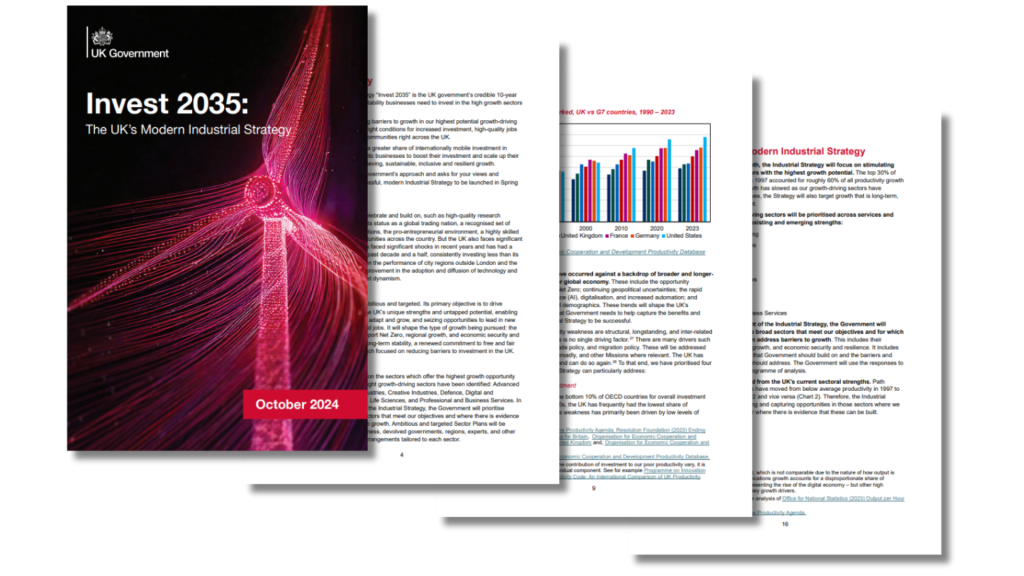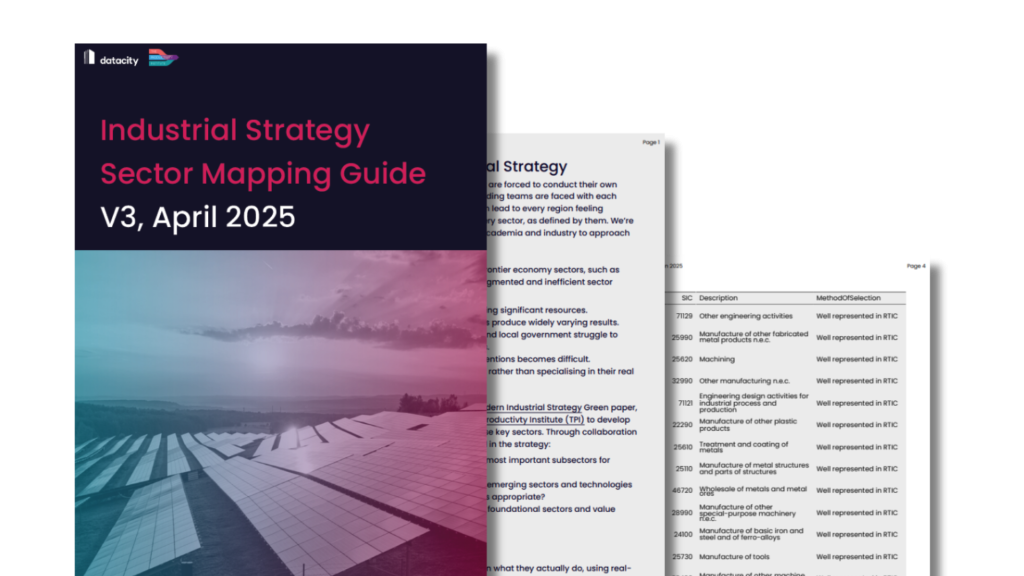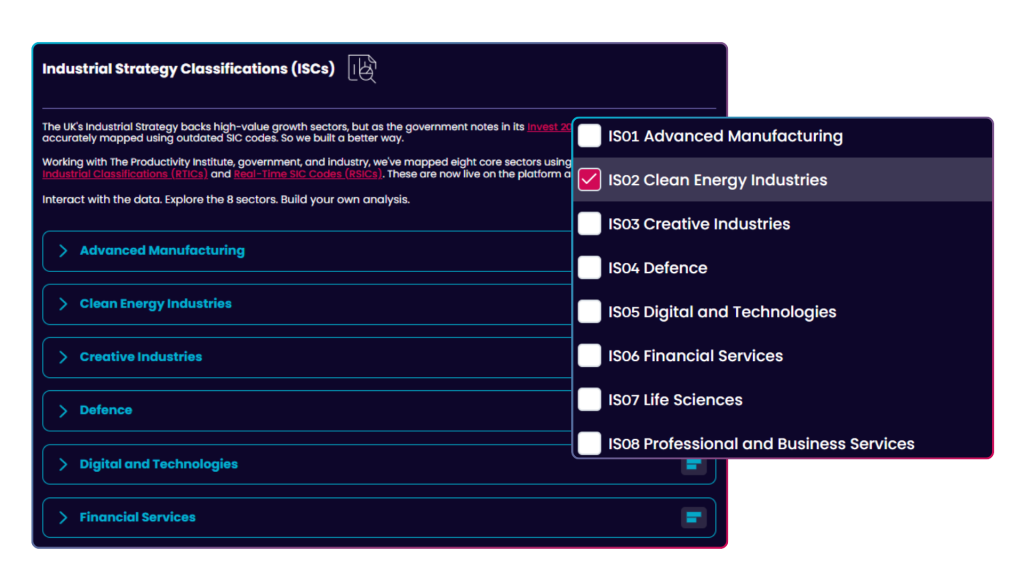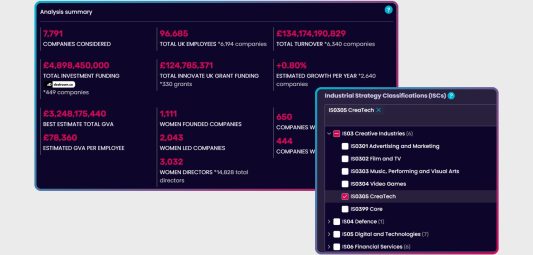Industrial strategy might sound like something that happens in a back room at Westminster, but it’s not. It’s about where we put our energy as a country. Where we direct funding, policy, and skills. Which industries we back. And ultimately, how we build the future.
The UK’s industrial strategy has been refreshed and re-energised. It’s more focused. More targeted. It sets out eight sectors that will shape the country’s economic direction – everything from clean energy and life sciences, to digital tech and advanced manufacturing.
Picking priority sectors is a start. But turning that into real action means knowing who’s in those sectors, where they are, and what they actually do. That’s where most systems fall down.
The issues in understanding UK sectors
Ask ten organisations to map something like Advanced Manufacturing, and you’ll get ten completely different answers.

That’s not just inconvenient – it’s a real problem. Because it means regions end up competing with each other using different definitions. It means analysts rebuild the same sectors from scratch every time. And it means national decisions are often made using fuzzy, inconsistent views of the economy.
This isn’t anyone’s fault. It’s just the reality of working with data systems that haven’t kept up. SIC codes – the classification system still used across government and industry – were last updated in 2007. They can’t tell you much about AI, CleanTech, or the Space Economy. And they definitely can’t reflect the crossover and complexity we see in modern sectors.
Our role in mapping the Industrial Strategy
We classify companies based on what they do – using AI and web data, not outdated codes. Our Real-Time Industrial Classifications (RTICs) offer a clear, accurate view of modern sectors. Built with experts and used across government, RTICs help create a shared, up-to-date evidence base.
When the Industrial Strategy Green Paper named eight high-growth sectors, we stepped in to define them properly – so everyone can work from the same map.

From first draft to shared foundation
We started by publishing Version 1 of our Industrial Strategy sector mapping guide back in January 2025 – a first take to kick-start collaboration. It was always meant to be a conversation, not a finished product. Version 2 brought in feedback from government departments, regional authorities and research partners, helping us refine the definitions and better understand how these sectors overlap.
Now, we’re launching Version 3 – and this time, it’s fully integrated into our platform.
This version builds on feedback from government, academia and industry to sharpen how we define and measure the UK’s high-growth sectors. Key updates include:
- Defence: Now being refined in collaboration with ADS Group to deliver a more forward-looking, sector-specific RTIC.
- Digital and Technology: Space activity has been reclassified into a new Space Economy RTIC, developed with DSIT to reflect cross-cutting innovation.
- Advanced Manufacturing: Robotics and autonomy activity has moved into the Space Economy RTIC to better reflect sector overlaps.
- Live in the platform: The full mapping is now integrated into The Data City platform. Explore overlaps, cluster strengths and regional distribution in real time.
- RSICs unlocked: Real-Time SIC Codes are now available for all eight Industrial Strategy sectors—no upgrade needed.
You can find out more and download our V3 Industrial Strategy Sector Mapping Guide today.
The data is live and ready to use
This isn’t a static report. It’s a working, real-time map of the UK economy. Whether you’re shaping national policy, building a local growth plan, or just want to understand what your region is actually good at – this data is now available.
Using the mapping from Version 3 of our guide, we’ve added a view of the eight growth-driving sectors outlined by UK government directly into The Data City platform.

Each sector brings together companies classified using a combination of our proprietary Real-Time Industrial Classifications (RTICs) – showcasing emerging industries and cutting-edge businesses – and our Real-Time SIC codes (RSICs), where we’ve used AI to correct outdated SIC data and assign companies the most relevant codes from the existing SIC framework.
If you’re already using our platform, you can explore these sectors today using the new filters in EXPLORE and ANALYSE.
For example, click into Advanced Manufacturing in ANALYSE and get a complete, real-time overview of the sector in the UK. See the number of companies, employees and investment, identify hotspots, explore trade data, and spot crossover with other sectors.
Want to go deeper? You can layer in regional filters, focus on high-growth companies, drill into subsectors to suit your analysis or view individual companies in EXPLORE.
And if you’re not yet on the platform, you can sign up for a free trial to see the data in action.
Let’s keep building it together
Version 3 is the most detailed and collaborative mapping we’ve done yet – but it’s still just the start. The economy is constantly evolving. New industries are emerging. And with every user, we learn more about how this data can support better decisions.
So whether you’re a policymaker, analyst, researcher, or investor – if you’re working in or around these sectors, we want to hear from you. Let’s improve the map, together.
To find out more please get in touch or sign up for a free trial today.


